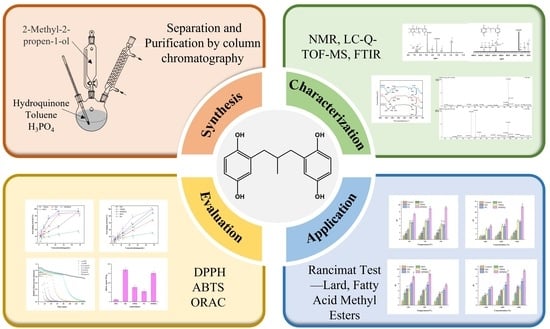Synthesis, Characterization and Evaluation of a Novel Tetraphenolic Compound as a Potential Antioxidant
Abstract
1. Introduction
2. Materials and Methods
2.1. Materials
2.2. Synthesis of MPBHQ
2.3. Content of MPBHQ
2.4. Separation and Purification
2.5. Identification of the Structure of MPBHQ
2.6. Retention Factor Value
2.7. Free-Radical Scavenging Assay
2.8. ORAC Assay
2.9. Rancimat Test
2.10. Statistical Analysis
3. Results and Discussion
3.1. Synthesis, Purification and Characterization of MPBHQ
3.2. DPPH Radical Scavenging Assay
3.3. ABTS Radical Scavenging Assay
3.4. ORAC Assay
3.5. Antioxidant Activity in Lard and Fatty Acid Methyl Esters—Rancimat Test
4. Conclusions
Author Contributions
Funding
Institutional Review Board Statement
Informed Consent Statement
Data Availability Statement
Conflicts of Interest
References
- Farooq, S.; Abdullah; Zhang, H.; Weiss, J. A comprehensive review on polarity, partitioning, and interactions of phenolic antioxidants at oil–water interface of food emulsions. Compr. Rev. Food Sci. Food Saf. 2021, 20, 4250–4277. [Google Scholar] [CrossRef]
- Shahidi, F.; Ambigaipalan, P. Phenolics and polyphenolics in foods, beverages and spices: Antioxidant activity and health effects. J. Funct. Foods 2015, 18, 820–897. [Google Scholar] [CrossRef]
- Zawawi, N.; Chong, P.J.; Mohd Tom, N.N.; Saiful Anuar, N.S.; Mohammad, S.M.; Ismail, N.; Jusoh, A.Z. Establishing Relationship between Vitamins, Total Phenolic and Total Flavonoid Content and Antioxidant Activities in Various Honey Types. Molecules 2021, 26, 4399. [Google Scholar] [CrossRef]
- Caleja, C.; Finimundy, T.C.; Pereira, C.; Barros, L.; Calhelha, R.C.; Sokovic, M.; Ivanov, M.; Carvalho, A.M.; Rosa, E.; Ferreira, I. Challenges of traditional herbal teas: Plant infusions and their mixtures with bioactive properties. Food Funct. 2019, 10, 5939–5951. [Google Scholar] [CrossRef]
- Guo, Y.; Amorati, R.; Valgimigli, L. Synergic antioxidant activity of γ-Terpinene with phenols and polyphenols enabled by hydroperoxyl radicals. Food Chem. 2020, 345, 128468. [Google Scholar] [CrossRef]
- Keramat, S.; Sharebiani, H.; Patel, M.; Fazeli, B.; Stanek, A. The potential role of antioxidants in the treatment of peripheral arterial disease. A Systematic Review. Antioxidants 2022, 11, 2126. [Google Scholar] [CrossRef]
- Costa, R.; Santos, L. Delivery systems for cosmetics—From manufacturing to the skin of natural antioxidants. Powder Technol. 2017, 86, 306–320. [Google Scholar] [CrossRef]
- Zhang, F.; Li, J.; Yang, S.; Bi, Y. Inhibitory effect of antioxidants on biodiesel crystallization: Revealing the role of antioxidants. Fuel 2021, 297, 120782. [Google Scholar] [CrossRef]
- Sun, H.; Chen, D.; Cai, H.; Chang, W.; Wang, Z.; Liu, G.; Deng, X.; Chen, Z. Effects of fermenting the plant fraction of a complete feed on the growth performance, nutrient utilization, antioxidant functions, meat quality, and intestinal Microbiota of Broilers. Animals 2022, 12, 2870. [Google Scholar] [CrossRef]
- Rodil, R.; Quintana, J.B.; Basaglia, G.; Pietrogrande, M.C.; Cela, R. Determination of synthetic phenolic antioxidants and their metabolites in water samples by downscaled solid-phase extraction, silylation and gas chromatography–mass spectrometry. J. Chromatogr. A 2010, 1217, 6428–6435. [Google Scholar] [CrossRef]
- Li, Z.J.; Yang, F.J.; Yang, L.; Zu, Y.G. Comparison of the antioxidant effects of carnosic acid and synthetic antioxidants on tara seed oil. Chem. Cent. J. 2018, 12, 12–37. [Google Scholar] [CrossRef]
- Liu, R.; Song, S.; Lin, Y.; Ruan, T.; Jiang, G. Occurrence of synthetic phenolic antioxidants and major metabolites in municipal Sewage Sludge in China. Environ. Sci. Technol. 2015, 9, 2073–2080. [Google Scholar] [CrossRef]
- Liu, R.; Mabury, S.A. Synthetic phenolic antioxidants in personal care products in Toronto, Canada: Occurrence, human exposure, and discharge via greywater. Environ. Sci. Technol. 2019, 6, 7–12. [Google Scholar] [CrossRef] [PubMed]
- Liu, C.; Li, J.; Bi, Y.; Wang, X.; Sun, S.; Yang, G. Thermal losses of tertiary Butylhydroquinone (TBHQ) and its effect on the qualities of palm oil. J. Oleo Sci. 2016, 65, 739–748. [Google Scholar] [CrossRef] [PubMed]
- Yu, N.; Ye, Q.; Nie, X.; Xia, C.; Meng, X. Distribution of 2-tert-butyl-1,4-benzoquinone and its precursor, tert-butylhydroquinone, in typical edible oils and oleaginous foods marketed in Hangzhou City, China. Food Chem. 2021, 361, 130039. [Google Scholar] [CrossRef] [PubMed]
- Cui, H.; Tao, F.; Hou, Y.; Lu, Y.; Zheng, T.; Sang, S.; Lv, L. Dual effects of propyl gallate and its methylglyoxal adduct on carbonyl stress and oxidative stress. Food Chem. 2018, 265, 227–232. [Google Scholar] [CrossRef]
- Ye, Q.; Meng, X.; Jiang, L. Identification and assessment of residual levels of the main oxidation product of tert-butylhydroquinone in frying oils after heating and its cytotoxicity to RAW 264.7 cells. Food Chem. 2018, 264, 293–300. [Google Scholar] [CrossRef]
- Olajide, T.M.; Pasdar, H.; Weng, X.C. A novel antioxidant: 6,6′-(butane-1,1-diyl)bis(4-methylbenzene-1,2-diol). Grasas Aceites 2018, 69, e269. [Google Scholar] [CrossRef]
- Jiang, Z.W.; Weng, X.C.; Huang, Y.; Hou, J.P.; Liao, X.Y. Synthesis and antioxidant activity of two novel tetraphenolic compounds derived from toluhydroquinone and tertiary butylhydroquinone. Grasas Aceites 2014, 65, e16. [Google Scholar] [CrossRef]
- Owolabi, J.O.; Fabiyi, O.S.; Adelakin, L.A.; Ekwerike, M.C. Effects of skin lightening Cream Agents—Hydroquinone and Kojic Acid, on the skin of adult female experimental rats. Clin. Cosmet. Investig. Dermatol. 2020, 13, 283–289. [Google Scholar] [CrossRef]
- Searle, T.; Al-Niaimi, F.; Ali, F.R. Hydroquinone: Myths and reality. Clin. Exp. Dermatol. 2020, 4, 636–640. [Google Scholar] [CrossRef] [PubMed]
- Jordán, M.J.; Lax, V.; Rota, M.C.; Lorán, S.; Sotomayor, J.A. Relevance of carnosic acid, carnosol, and rosmarinic acid concentrations in the in vitro antioxidant and antimicrobial activities of Rosmarinus officinalis (L.) methanolic extracts. J. Agric. Food Chem. 2012, 60, 9603–9608. [Google Scholar] [CrossRef] [PubMed]
- Li, P.; Yang, X.; Lee, W.J.; Huang, F.; Wang, Y.; Li, Y. Comparison between synthetic and rosemary-based antioxidants for the deep frying of French fries in refined soybean oils evaluated by chemical and non-destructive rapid methods. Food Chem. 2021, 335, 127638. [Google Scholar] [CrossRef] [PubMed]
- Huang, Y.; Jiang, Z.; Liao, X.; Hou, J.; Weng, X. Antioxidant activities of two novel synthetic methylbenzenediol derivatives. Czech J. Food Sci. 2014, 32, 348–353. [Google Scholar] [CrossRef]
- Kodomari, M.; Nawa, S.; Miyoshi, T. Direct allylation of aromatic compounds with allylic chloride using the supported reagents system ZnCl2/SiO2/K2CO3/Al2O3. J. Chem. Soc. Chem. Commun. 1995, 18, 18–25. [Google Scholar] [CrossRef]
- Feng, Y.; Zhang, X. Polysaccharide extracted from Huperzia serrata using response surface methodology and its biological activity. Int. J. Biol. Macromol. 2020, 157, 267–275. [Google Scholar] [CrossRef]
- Chen, Z.; Bertin, R.; Froldi, G. EC50 estimation of antioxidant activity in DPPH assay using several statistical programs. Food Chem. 2013, 138, 414–420. [Google Scholar] [CrossRef]
- Shi, B.; Yu, J.; Tang, T.; Yuan, L.; Tang, Y. Study on UV spectrum and antioxidant properties of 3-tert-Butyl-4-hydroxyanisole molecule. Russ. J. Phys. Chem. A 2021, 95, 343–348. [Google Scholar] [CrossRef]
- Shi, G.; Liao, X.; Olajide, T.M.; Liu, J.; Jiang, X.; Weng, X. Butylated caffeic acid: An efficient novel antioxidant. Grasas Aceites 2017, 68, 201. [Google Scholar] [CrossRef]
- Schaich, K.M.; Tian, X.; Xie, J. Hurdles and pitfalls in measuring antioxidant efficacy: A critical evaluation of ABTS, DPPH, and ORAC assays. J. Funct. Foods 2015, 14, 111–125. [Google Scholar] [CrossRef]
- Tian, X.; Schaich, K.M. Effects of Molecular Structure on Kinetics and Dynamics of the Trolox Equivalent Antioxidant Capacity Assay with ABTS+•. J. Agric. Food Chem. 2013, 61, 5511–5519. [Google Scholar] [CrossRef]
- Wen, W.; Weng, X.; Cheng, D. Antioxidant activities of natural phenolic components from Dalbergia odorifera T. Chen. Food Chem. 2000, 71, 45–49. [Google Scholar] [CrossRef]
- Symoniuk, E.; Ratusz, K.; Krygier, K. Comparison of the oxidative stability of linseed (Linum usitatissimum L.) oil by pressure differential scanning calorimetry and Rancimat measurements. J. Food Sci. Technol. 2016, 53, 3986–3995. [Google Scholar] [CrossRef] [PubMed]
- Kajiyama, T.; Ohkatsu, Y. Effect of para-substituents of phenolic antioxidants. Polym. Degrad. Stab. 2001, 71, 445–452. [Google Scholar] [CrossRef]
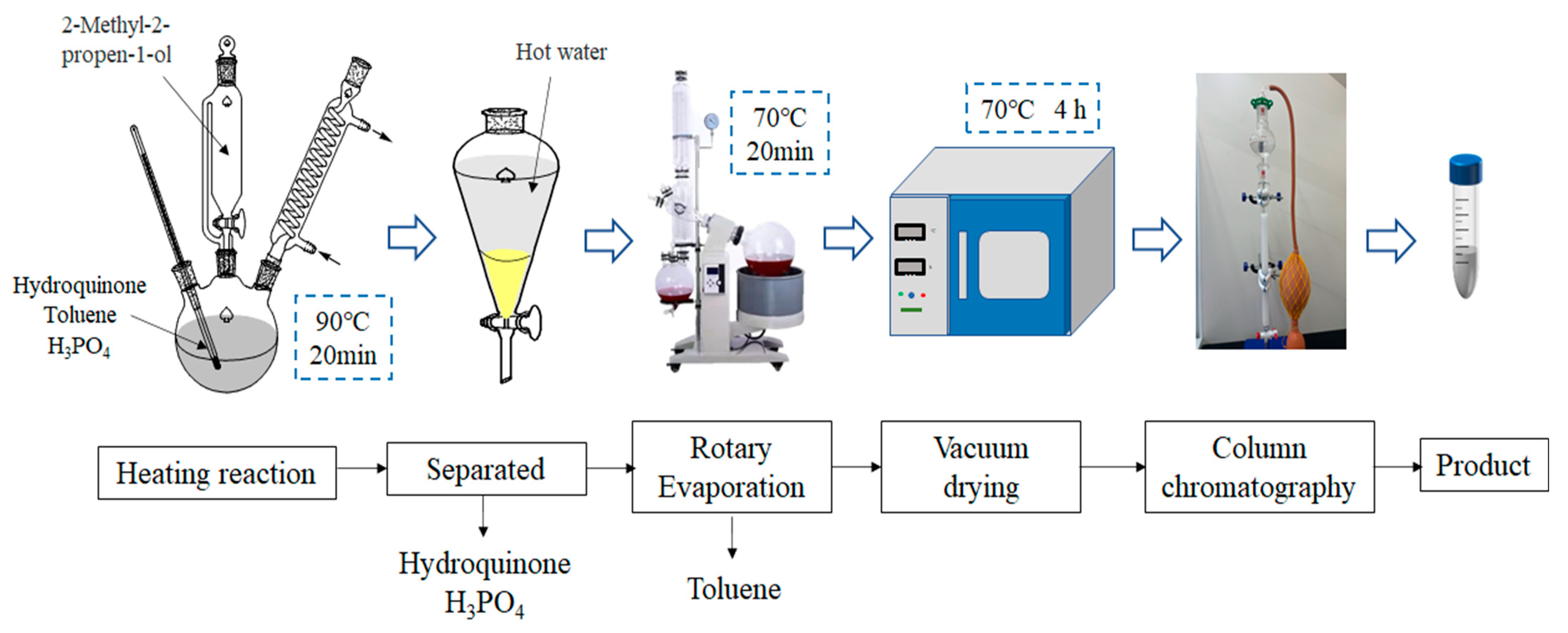
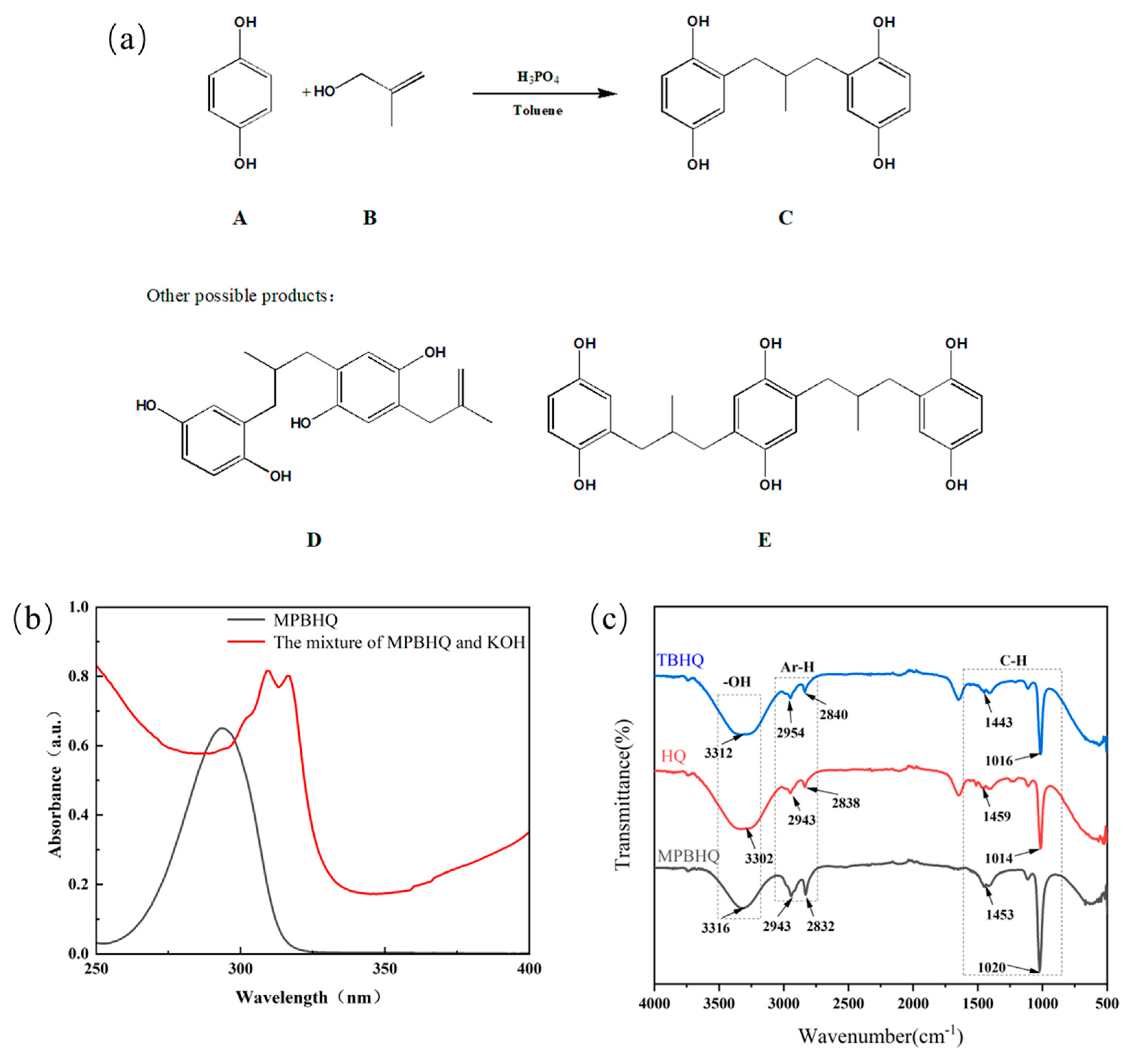
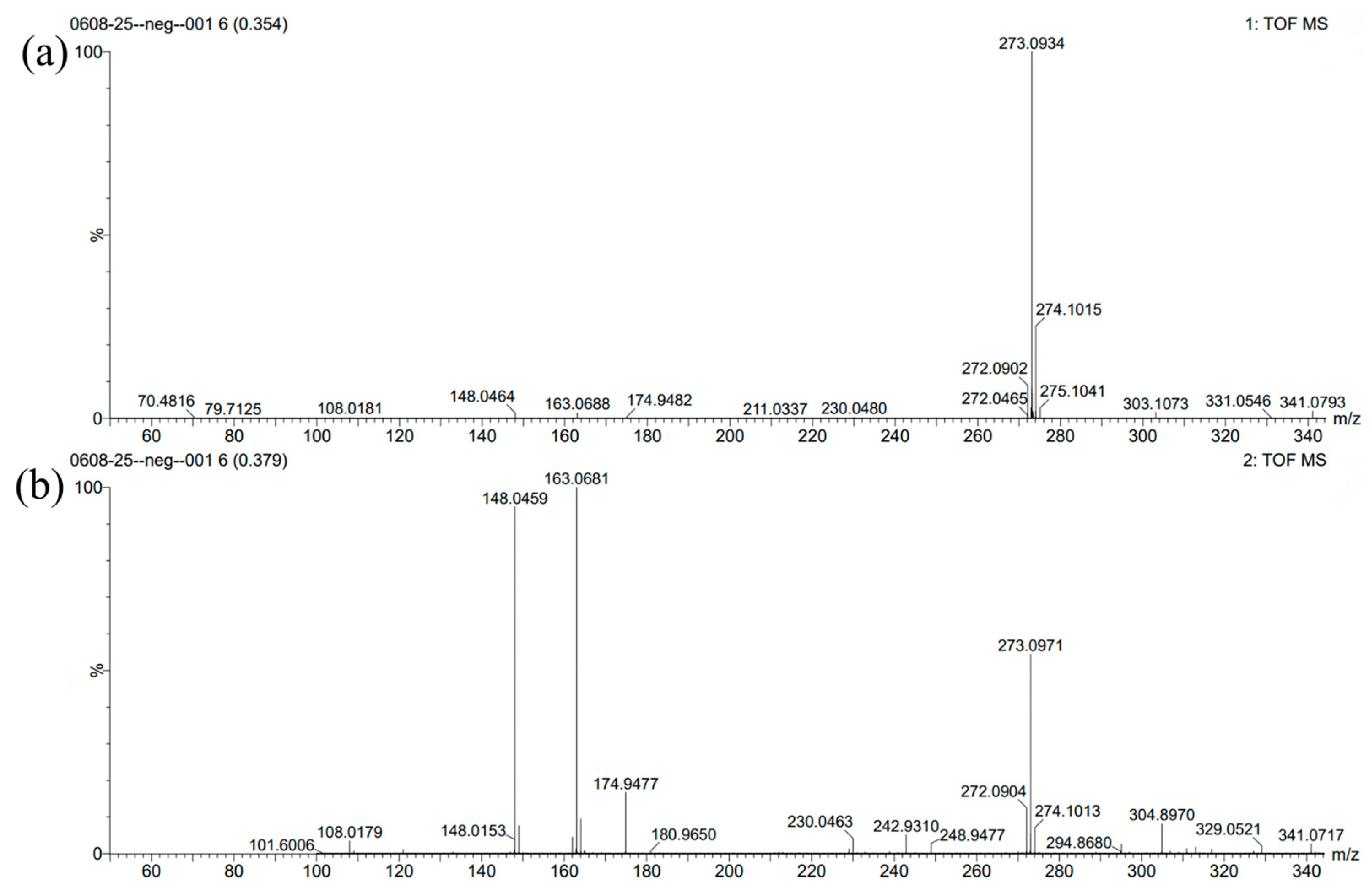
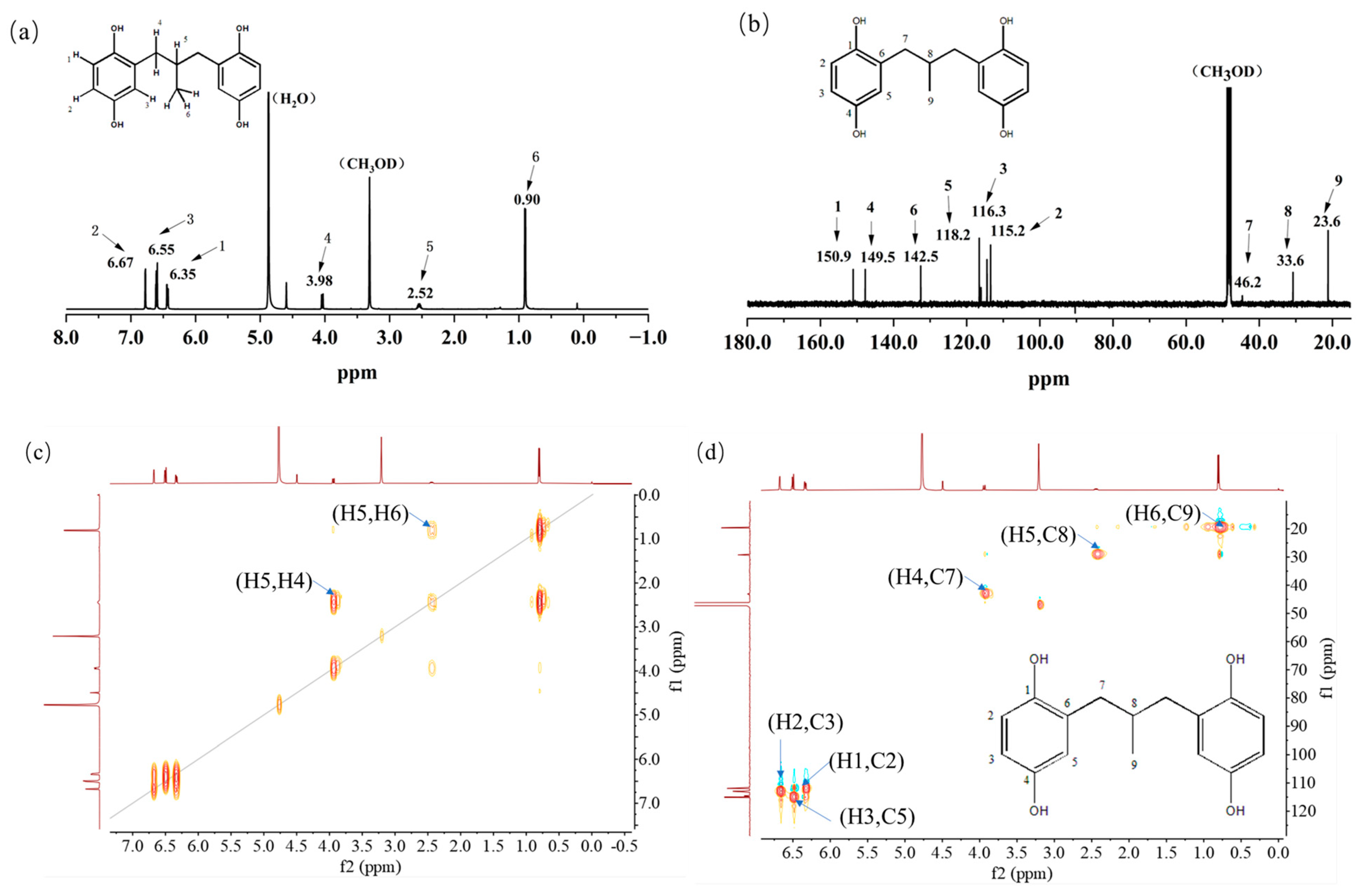
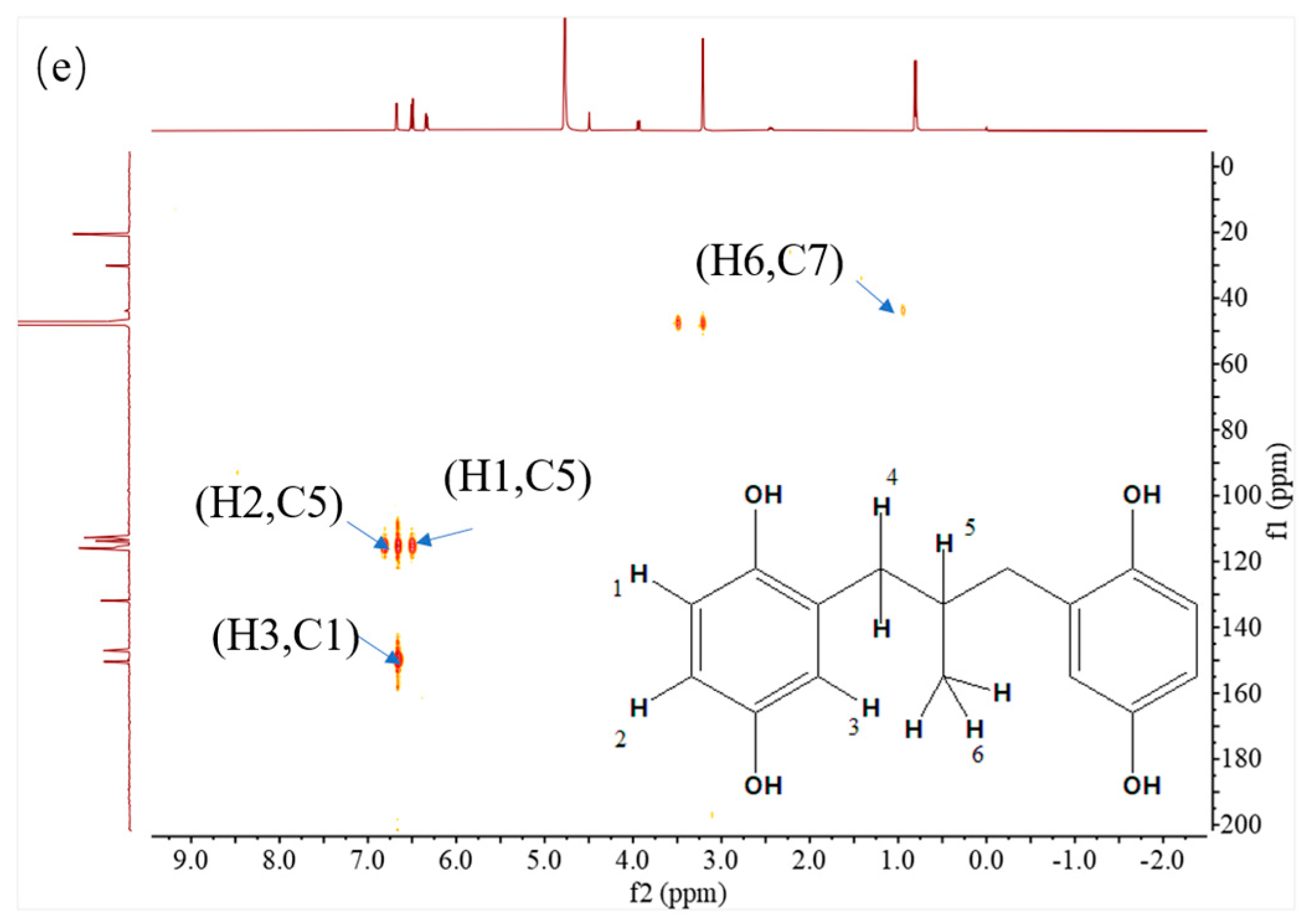
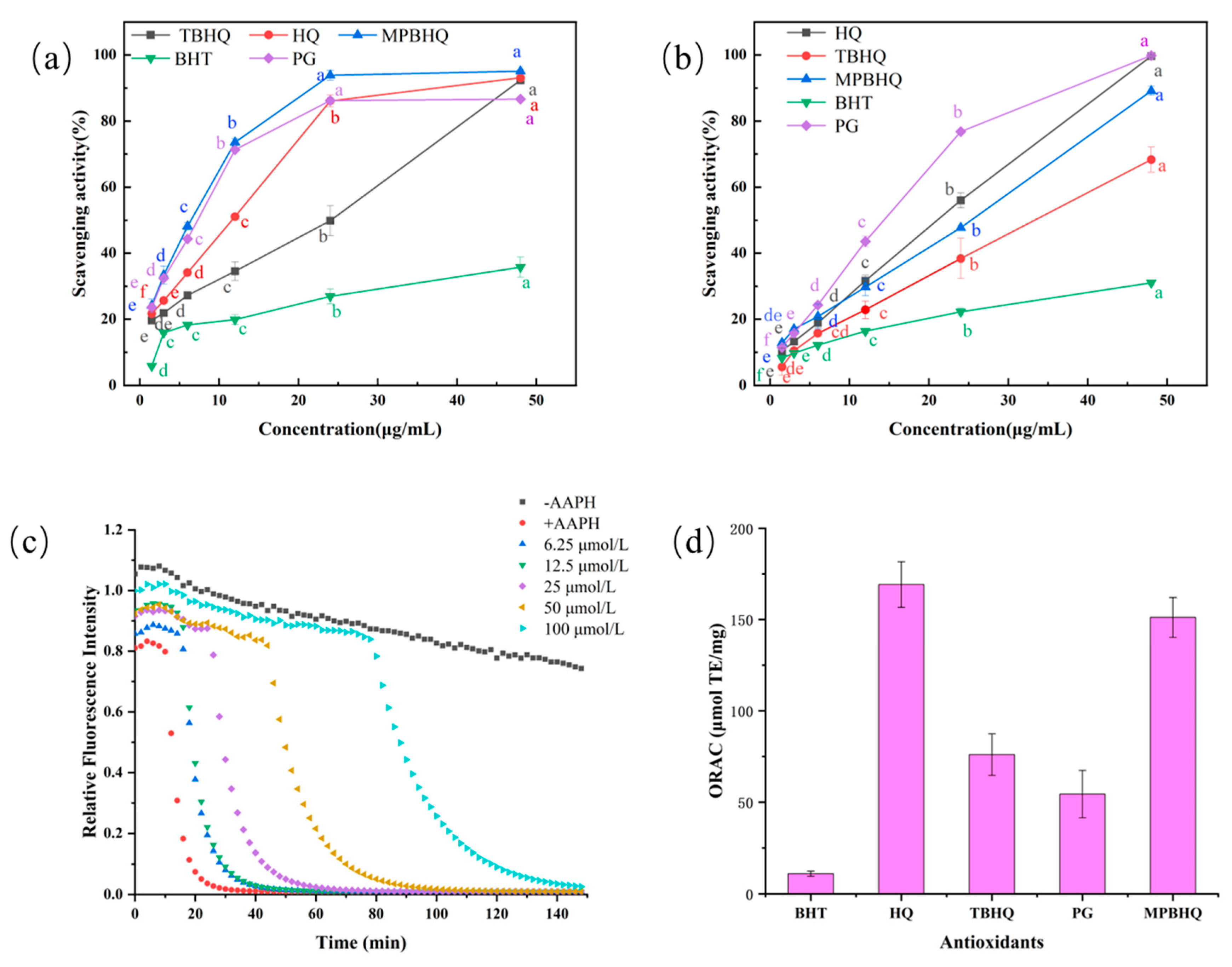
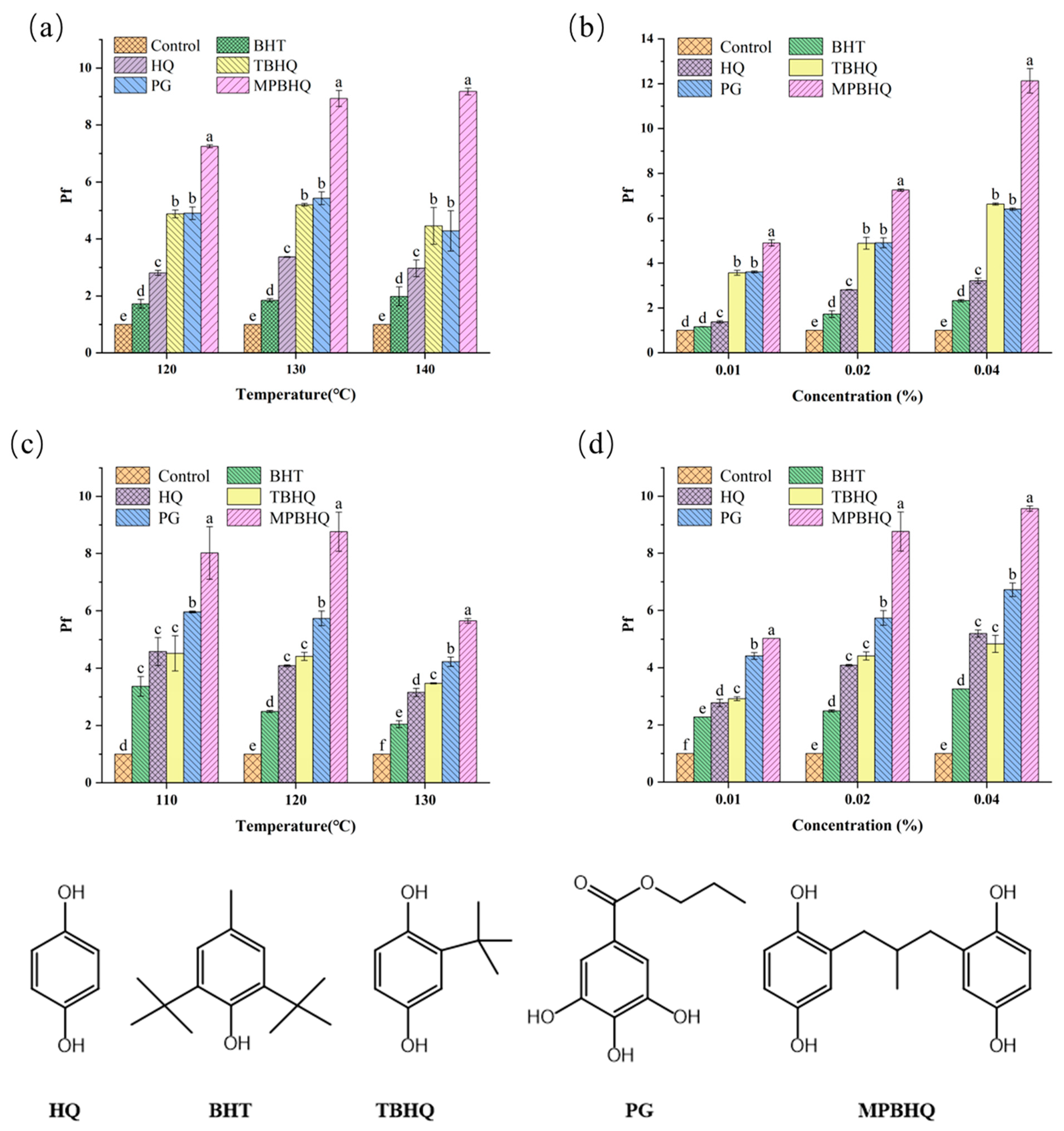
| Temperature (°C) | Molar Ratio of Phenol to Alcohol | Time (min) | Composition of the Reaction Products (%) | |||
|---|---|---|---|---|---|---|
| HQ | MPBHQ | Others | ||||
| 1 | 90 | 1:2 | 20 | 25 | 20 | 55 |
| 2 | 120 | 1:1 | 40 | 37 | 10 | 53 |
| 3 | 60 | 1:2 | 20 | 52 | 20 | 28 |
| 4 | 90 | 1:1.2 | 20 | 22 | 41 | 37 |
| Antioxidant | Structure | Condition of DPPH | EC50/μg·mL−1 | Condition of Rancimat | Pf | Reference |
|---|---|---|---|---|---|---|
| Compound 1 | 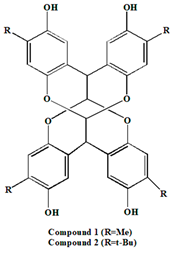 | 0.5 mL of sample, 2.5 mL of DPPH (0.1 mM) | 31.64 | 3 g of lard, 120 °C, 0.02% of antioxidant, 20 L/h air flow rate | 6.12 | [19] |
| Compound 2 | 0.5 mL of sample, 2.5 mL of DPPH (0.1 mM) | 106.95 | 3 g of lard, 120 °C, 0.02% of antioxidant, 20 L/h air flow rate | 7.28 | [19] | |
| BMB | 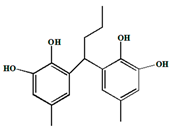 | 0.5 mL of sample, 3 mL of DPPH (0.1 mM) | 24.39 | 3 g of lard, 120 °C, 0.02% of antioxidant, 20 L/h air flow rate | 14.85 | [18] |
| MPBHQ | 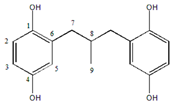 | 0.5 mL of sample, 3 mL of DPPH (0.1 mM) | 7.93 | 3 g of lard, 120 °C, 0.02% of antioxidant, 20 L/h air flow rate | 7.25 | This work |
| TBHQ | 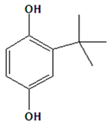 | 0.5 mL of sample, 3 mL of DPPH (0.1 mM) | 22.20 | 3 g of lard, 120 °C, 0.02% of antioxidant, 20 L/h air flow rate | 4.88 | This work |
| PG | 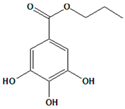 | 0.5 mL of sample, 3 mL of DPPH (0.1 mM) | 11.34 | 3 g of lard, 120 °C, 0.02% of antioxidant, 20 L/h air flow rate | 4.90 | This work |
Disclaimer/Publisher’s Note: The statements, opinions and data contained in all publications are solely those of the individual author(s) and contributor(s) and not of MDPI and/or the editor(s). MDPI and/or the editor(s) disclaim responsibility for any injury to people or property resulting from any ideas, methods, instructions or products referred to in the content. |
© 2023 by the authors. Licensee MDPI, Basel, Switzerland. This article is an open access article distributed under the terms and conditions of the Creative Commons Attribution (CC BY) license (https://creativecommons.org/licenses/by/4.0/).
Share and Cite
Xu, M.; Meng, P.; Wang, H.; Liu, J.; Guo, T.; Zhu, Z.; Bi, Y. Synthesis, Characterization and Evaluation of a Novel Tetraphenolic Compound as a Potential Antioxidant. Antioxidants 2023, 12, 1473. https://doi.org/10.3390/antiox12071473
Xu M, Meng P, Wang H, Liu J, Guo T, Zhu Z, Bi Y. Synthesis, Characterization and Evaluation of a Novel Tetraphenolic Compound as a Potential Antioxidant. Antioxidants. 2023; 12(7):1473. https://doi.org/10.3390/antiox12071473
Chicago/Turabian StyleXu, Mengqi, Pengcheng Meng, Hongyan Wang, Jun Liu, Tao Guo, Zhenjie Zhu, and Yanlan Bi. 2023. "Synthesis, Characterization and Evaluation of a Novel Tetraphenolic Compound as a Potential Antioxidant" Antioxidants 12, no. 7: 1473. https://doi.org/10.3390/antiox12071473
APA StyleXu, M., Meng, P., Wang, H., Liu, J., Guo, T., Zhu, Z., & Bi, Y. (2023). Synthesis, Characterization and Evaluation of a Novel Tetraphenolic Compound as a Potential Antioxidant. Antioxidants, 12(7), 1473. https://doi.org/10.3390/antiox12071473




